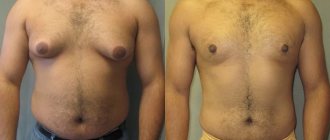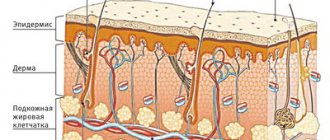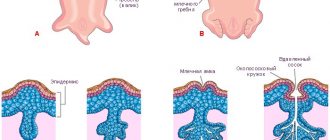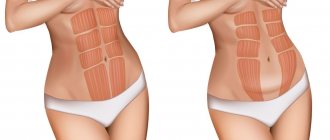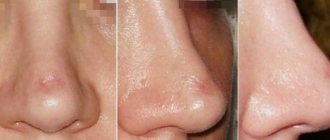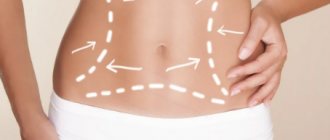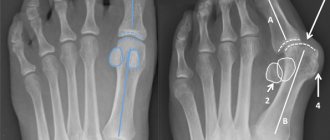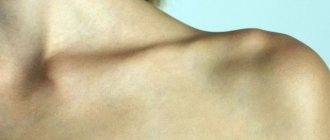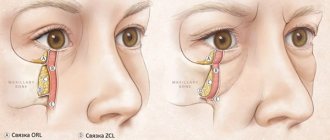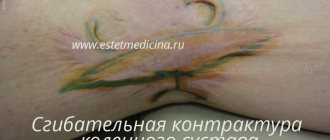An umbilical hernia is perhaps one of the most common types of hernia of the anterior abdominal wall. The prerequisite for its appearance is the umbilical ring that each of us has, through which we once received nutrition and oxygen in the womb. Subsequently, it closes and the diameter of the umbilical ring does not exceed a few millimeters, but in some people this process is disrupted and a congenital umbilical hernia occurs.
In most children, the hernia resolves on its own by age 2, but if this does not happen by age 5, surgical repair of the hernia will likely be required. In adults, the umbilical ring expands with increased intra-abdominal pressure; we have already written about risk factors and the mechanism of hernia occurrence. Very often, an umbilical hernia appears with diastasis of the rectus abdominis muscles during pregnancy or in overweight patients, when the umbilical ring stretches along with the white line.
In adults, it is not possible to talk about the spontaneous disappearance of the hernia, given the high (30%) risk of strangulation and high mortality during its development - an umbilical hernia requires surgical treatment.
Plastic methods
An umbilical hernia can be repaired using open or laparoscopic surgery. The main advantage of laparoscopic umbilical hernia repair is minimal trauma and, accordingly, quick rehabilitation. This is especially obvious with medium and large hernias, laparoscopic repair of which is performed using three small punctures (1.5, 0.5 and 0.5 cm), while an open one requires a fairly large incision - 8-10 cm or more.
Rice. 1. For small umbilical hernias, the advantages of laparoscopic repair are less obvious: with a small size of the defect, it can be completely eliminated from a small (1.5-2 cm) local access, without resorting to laparoscopic technology, achieving an equally good result.
Diagnosis of umbilical hernia
Usually the patient himself diagnoses an umbilical hernia, since its location is characteristic, and the soft, densely elastic consistency and rumbling due to intestinal peristalsis completely facilitate the diagnosis. Sometimes the liver or stomach gets into the hernia, then diagnosis is difficult. To determine the diagnosis, the surgeon examines the patient, palpates and listens with a stethoscope to the formation in the navel area, and, if necessary, conducts an ultrasound examination and X-ray of the formation.
Since surgery for an umbilical hernia is a mandatory measure, its implementation is only a matter of time, a general blood test, urine test, blood biochemistry and coagulogram, as well as a test for viral hepatitis and HIV, are required. This is the minimum set of tests to prepare for surgery.
Do you need a mesh?
Repair of medium and large umbilical hernia without the use of a mesh implant is currently unacceptable and leads to a high risk of relapse (20-45%). For small hernias, up to 2 cm, repair with local tissues is possible; the risk of recurrence, according to world literature, is 4.1-6.6%. We perform plastic surgery with local tissues only for very small diameters of the umbilical ring, not exceeding 10 mm. All others - only with additional reinforcement using mesh. The size of the implant also depends on the size of the defect: the implant should cover it by approximately 3 cm in each direction. Accordingly, the minimum size of the mesh used is 6x6 cm. Modern mesh implants (and we use “light” meshes) even of large sizes are not felt by patients in any way and do not reduce the functionality of the anterior abdominal wall.
Symptoms and signs
The main sign of the presence of an umbilical hernia in adults is protrusion of the navel of varying degrees of severity. Essentially, a hernia looks like a lump on your stomach. You can detect a protrusion on your own by placing your fingers on the navel and straining your stomach or coughing. At the same time, a push will be felt under your fingers.
A small hernia can be easily reduced. But it will probably come out again. A large hernia is often accompanied by umbilical adhesions and cannot be simply repaired. In addition, with an advanced hernia, the patient is often bothered by nausea and vomiting, and problems with stool. If organs adjacent to the navel are “pulled” into the hernia, this can be accompanied by many unpleasant symptoms. For example, problems with urination.
The hernia itself does not hurt. But when overexerted, pain appears. Pinched organs can also be painful. If the hernia is not treated in time, it can involve most of the peritoneal organs.
How is the operation performed?
Plastic surgery for any hernia consists of several stages:
- access (incision over the hernia or installation of ports for laparoscopy)
- isolation and removal of the hernial sac
- actual closure of the defect of the anterior abdominal wall (hernial orifice)
For small umbilical hernias, with a defect size of up to 10 mm, as we have already said, it is enough to perform plastic surgery with local tissues. Most often we use edge-to-edge suturing (Spitzy operation) or Mayo plastic surgery to create a double layer of aponeurosis.
Rice. 2. Operation Spitzy. From Hernia Surgery by V. Schumpelick, G. Arlt, J. Conze, K. Junge. Georg Thieme Verlag, 2019
Rice. 3. Mayo operation. From Hernia Surgery by V. Schumpelick, G. Arlt, J. Conze, K. Junge. Georg Thieme Verlag, 2019
For hernias with a defect of more than 2 cm, we consider it mandatory to use a mesh implant
. It can be installed in the preperitoneal, retromuscular space of the anterior abdominal wall or in the abdominal cavity. In the latter case, implants with a special coating are used to prevent contact of the polypropylene, which the mesh is made of, with the abdominal organs to prevent the formation of adhesions.
Rice. 4. Implantation of the mesh into the preperitoneal space. From Hernia Surgery by V. Schumpelick, G. Arlt, J. Conze, K. Junge. Georg Thieme Verlag, 2019
Mesh implantation into any of these spaces is possible either open or laparoscopically.
Rice. 5. Closing the defect with a combined implant with an anti-adhesion layer made of polytetrafluoroethylene (Teflon)
Abdominoplasty with hernia truncation
The canons of female beauty have remained unchanged for thousands of years. Sloping hips, an expressive, clearly defined waist, and a flat, sculpted stomach create a graceful figure that attracts the gaze of men. You can get ideal body contours without plastic surgery, but there are many problems that only a plastic surgery center can solve.
After pregnancy, sudden weight loss, serious illnesses or injuries, the contours of the abdomen, buttocks, and hips of the back become blurred. Even if everything is in order with your health, age-related changes cannot be avoided. The appearance of hernias warns that the abdominal muscles are greatly stretched, have lost their plasticity, and it is time to seek help from an experienced plastic surgeon.
Important!
Behind the outer layer of the skin-fatty membrane of the abdomen are the rectus abdominis muscles, then the peritoneum - a thin film that supports the intestines, internal organs, and muscle tissue. When the rectus muscles diverge under the influence of internal pressure, part of the intestine protrudes under the skin and forms a hernia. You can cope with the problem with the help of abdominoplasty, while simultaneously performing hernial orifice plastic surgery.
Reasons for the formation of hernias
The reasons for the formation of hernias lie in the characteristics of the human body. People often don't take very good care of their bodies until problems arise. The plastic surgery clinic of Dr. Alexander Markushin provides a wide range of services for people of different ages and genders. With sudden weight gain, difficult childbirth, excessive, prolonged physical activity, the appearance of a hernia is natural. The separated rectus abdominis muscles are unable to maintain intestinal pressure. The danger is especially high for those who do not strengthen their abs and lead a passive lifestyle.
The root cause leading to the appearance of hernias may be sudden lifting of weights, strong efforts during childbirth, strong, frequent sneezing or coughing, frequent constipation, the use of weights for training that exceed the permissible norms. Children can develop a hernia if they scream a lot, are capricious, or eat improperly. Parents should watch closely to watch for the appearance of small swellings. During the consultation, the surgeon will determine the degree of disturbances that have occurred in the body and choose a technique to eliminate the defect. Hernioplasty and abdominoplasty are an ideal way to quickly solve an existing problem.
Truncating hernias during abdominoplasty
Surgeons say that one should not hesitate to remove a hernia. Delaying surgery can lead to strangulation, which will then require more complex surgery, which can lead to serious complications. You can’t rely on diets, massage, adjustments, or physiotherapeutic procedures. Any delays most often end in failure. Only surgery can quickly eliminate a hernia.
Laparoscopic abdominoplasty is used to remove small hernias. The surgeon uses a laparoscope to insert the necessary surgical instruments through a small incision to perform the operation. The minimally invasive technique guarantees excellent results, a short rehabilitation period, and leaves virtually no marks on the body. Within a few days you can go back to work.
With classic abdominoplasty, a step-by-step complex operation lasts from 2 to five hours. All manipulations are performed by a plastic surgeon while the patient is under general anesthesia.
- An incision is made above the pubis, up to 60 cm long.
- After this, a large flap of skin-fat tissue is peeled off.
- Having opened the hernial orifice, the doctor pushes part of the squeezed out intestine back into place in the abdominal cavity.
- The sac formed by tension of the peritoneum is excised.
- After this, the muscle tissues put in place are stitched together.
- The skin is stretched downward to eliminate folds and sagging.
- Excess skin is removed.
- The navel is placed in a new place in the center of the abdomen.
- Sutures are placed on the incisions.
The complex operation is performed by a highly qualified surgeon, Alexander Alexandrovich Markushin, who has extensive practical experience. Precise adherence to all the instructions of the attending physician will help to avoid complications.
Using implants to repair a hernia during abdominoplasty
To strengthen the frame of the muscle corset, Alexander Alexandrovich can use special implants. Endoprostheses are equally effective in laparoscopic or laparotomic abdominoplasty. Two main types of prosthesis are widely used.
- Polypropylene mesh. They are neutrally perceived by the body, without causing allergies or rejection. It is fixed during surgery with medical glue on the damaged area. Gradually overgrown with tissue, strong additional protection is formed at the site of the hernia. Properly performed prosthetics does not cause any discomfort.
- Self-resorbable implants. It is manufactured by industry in the form of a mesh from a special material. After the doctor places it at the site of the removed hernia. it copes well with the function of a protective barrier, gradually dissolving into the body. This is an ideal way to quickly repair emerging hernial orifices. This type of prosthesis is often used by women planning a new pregnancy.
On a note!
The choice of endoprosthesis always remains with the patient. The doctor recommends the best option based on your specific situation.
The importance of rapid hernia repair during tummy tuck
Correcting the shape of the figure is not an urgent procedure, since it does not in any way affect the vital functions of the body. You can live with aesthetic problems for a long time, while remaining completely healthy. If a hernia is detected, you cannot pull, since every day the chances of strangulation will increase, which can cause tissue necrosis, peritonitis or intestinal obstruction. You can get out of this situation with abdominoplasty or hernioplasty performed at a plastic surgery center.
Recovery after abdominoplasty with simultaneous repair of a hernia
No matter how the abdominoplasty with hernia truncation was performed, you must strictly follow the instructions of your attending physician to avoid complications. Until rehabilitation is completed, avoid heavy lifting, sports training, and running. The bandage worn after the operation can be removed only after the surgeon allows it, making sure that the scarring of the incision is completely completed. Watch your diet so that diarrhea, constipation or flatulence do not cause the sutures to separate.
By combining abdominoplasty with hernia removal, the patient radically changes his appearance, while simultaneously getting rid of a health-threatening problem.
Postoperative recovery
With open repair of small or laparoscopic repair of large umbilical hernias, recovery is equally fast. Typically, patients are discharged the day after surgery with one restriction - not to lift more than 10 kg for the first 3 months. This is due to the fact that the formation of a scar in the operation area occurs precisely during this period of time, and the load on the sutures should not exceed permissible values. Aerobic exercise (swimming, running, exercise bike, etc.) can be resumed a few weeks after surgery.
After hernioplasty
One of the advantages of laparoscopic surgery is rapid healing. Recovery after laparoscopy requires significantly less time than after abdominal surgery.
After laparoscopic hernioplasty
the patient needs to stay in the hospital under medical supervision (usually until the evening of the same day when the operation was performed). Pain in the puncture area usually goes away within one to two days. So in just two days you can return to your normal lifestyle, including driving. The only thing to avoid is significant physical activity and heavy lifting. In order to remove this restriction, you need to see a surgeon in about 2 weeks.
Preparing for surgery
Before surgery, it is necessary to undergo an examination to determine the general condition of the patient and identify possible contraindications. The patient undergoes blood tests, ECG and other studies in advance. Familiarize yourself with the procedure for hospitalization and the list of necessary tests before hernioplasty.
Staying in hospital
The timing of postoperative rehabilitation is determined not so much by the type of operation as by the type and size of the hernia.
As a rule, patients operated on for an umbilical hernia can be discharged the next day after both open and laparoscopic surgery.
Why do hernias appear?
All causes of hernia development are divided into two main groups: predisposing and producing . The first includes age, gender, physique, lifestyle. Producing causes are considered to be prolonged crying in childhood, frequent acute respiratory viral infections, heavy lifting and the presence of chronic diseases.
The following factors also contribute to the formation of hernias:
- hereditary connective tissue diseases;
- violation of tissue regeneration;
- damage to the respiratory system;
- chronic constipation due to an unbalanced diet, disorders of the stomach and intestines;
- sedentary lifestyle.
Diagnostics
A surgeon diagnoses an umbilical hernia. To determine the presence of a hernia, the doctor only needs to conduct an examination. An umbilical hernia itself is not dangerous. However, it is important to distinguish a hernia from a neoplasm or metastases of an oncological process in time, and also to prevent the development of the process of “pulling” organs into the hernia.
In addition to digital examination, the following methods are used to diagnose an umbilical hernia:
:
- X-ray of the stomach
- Esophagogastroduodenoscopy
- Ultrasound examination of the abdominal cavity
- Herniography
What types of operations exist and what are their features?
Tension plastic method. Previously, all patients with inguinal hernias were operated on only by tension plastic surgery using their own muscular aponeurotic tissues - they simply pulled together and sutured the edges of the hernial orifice. The recurrence rate of such hernia suturing is from 7 to 14% (the tissues diverged again after a couple of months).
Laparoscopic operations . Despite the fact that the operation is performed through punctures, the absence of incisions is more of a disadvantage than an advantage. There are a lot of punctures - at least 3, each of them is 2-3 centimeters long, and the stitch after open surgery is only 5-6 cm in the groin, cosmetic. Laparoscopy also has a number of other disadvantages: general anesthesia, long duration and traumatic operation, the possibility of developing serious complications from the abdominal organs. But the most serious disadvantage of laparoscopic surgery is the greater number of relapses; they occur 2-2.5 times more often compared to open tension-free surgery. All over the world, such operations for the treatment of hernias are no longer used.
Tension-free hernia repair using mesh implants.
In most clinics around the world, hernia repair using a mesh implant is the “gold standard” for hernia treatment, due to its obvious advantages.
According to various statistical data, which are discussed at all-Russian and international congresses of herniologists, the technology for removing a hernia using a mesh implant has the lowest relapse rate - 1%, compared to other types of operations. For more than 15 years, the surgical department of the Phlebology Center has been using only this method, as the most effective and reliable.
